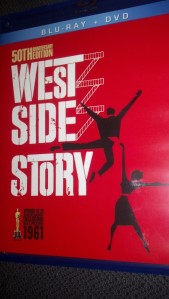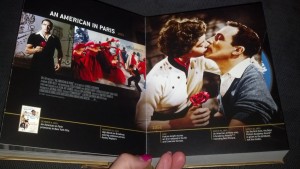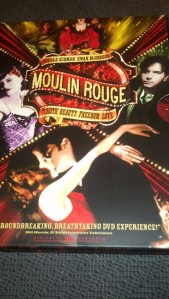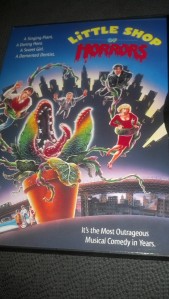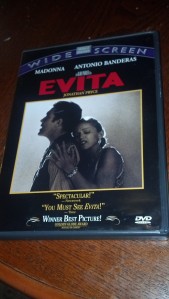The Task: Watch and write about every movie on my shelf, in order (Blu-rays are sorted after DVDs), by June 10, 2015. Remaining movies: 6 Days to go: 8
Movie #434: West Side Story
My mother-in-law bought me West Side Story three Christmases ago because she thought I would like it, and I haven’t watched it even once until today because I am an awful person. I knew stuff about the film, of course — more than I realized I did, it turns out — but before today my only first-hand experience with West Side Story was the backyard garden hose-assisted performance of “Jet Song” in Sleeping With the Enemy. “When you’re a Jet, you’re a Jet all the way, from your first cigarette to your last dying day.”
[At this point you should be really disappointed in the internet for not having this clip readily available anywhere, because it is fantastic.]
I had heard at one point or another that West Side Story was a modern (in the ’60s) remake of Romeo and Juliet, but it would be obvious even if I hadn’t known it going in. The warring gangs of Jets and Sharks are very clearly Montagues and Capulets, with the cross-boundaries love of Tony (Richard Beymer) and Maria (Natalie Wood) being the equivalent of the unlucky Shakespearian lovers, bound to their respective sides by blood, but with neither the heart nor the interest to partake in the pointless rivalry. They fall in love at first sight but are kept apart and have to keep their meetings quiet. There is even a secret wedding ceremony, of sorts, as Tony and Maria role play what it will be like. Then, at the rumble, everyone’s come with weapons hidden on their person just in case, even though it was supposed to be a fair fight — because neither side trusts the other. Tony tries to break things up but Bernardo (George Chakiris) taunts him. Then Riff (Russ Tamblyn) slugs Bernardo and the switchblades come out, which ends when Bernardo accidentally stabs and kills Riff and, lashing out, Tony accidentally stabs and kills Bernardo with Riff’s knife — just as Tybalt killed Mercutio and Romeo killed Tybalt. There is even the misinformation of Maria’s death given to Tony, leading Tony to seek out his own death at the hands of Chino (Jose DeVega), who has vowed to kill him as revenge for his killing Bernardo. And when Tony dies in Maria’s arms, she does, for a moment at least, entertain the thought of taking her own life. It’s an incredibly true homage to the original, decrying the pointlessness and futility of hatred and revenge, and I think anyone familiar with the Shakespeare play would recognize the correlations. West Side Story, though, also brings a lot more to its story to coincide with its modern setting, and it addresses themes that are not just relevant to fifty or sixty years ago but are still pertinent today.
What I really didn’t expect from West Side Story — despite going in knowing it was in part a conflict between whites and Puerto Ricans — was the intense examination of racism in their community, in the police force, and in American society as a whole. Without being preachy or stepping outside of its structure, it reflects how institutional racism is, how it’s tolerated and encouraged in the way we operate and the things we put up with. The police in West Side Story decry the hoodlums, but they clearly favor the Jets, who are white. When they’ve all been fighting, the police ask only which Puerto Ricans are responsible. When whispers of the upcoming Rumble abound, Lieutenant Schrank (Simon Oakland) openly offers to conspire with the Jets to destroy the Sharks, making him a bigger threat and a more destructive force to the neighborhood than either gang, even if it is the gangs who destroy each other in the end.
I also didn’t realize going in how many of these songs I was familiar with already. I knew “Jet Song,” of course, as I previously established. I also had heard “America,” no doubt from any one of a dozen Oscar tributes to the movies, to musicals, to Rita Moreno, or to some combination of the three. It’s a really great song — and also more about race relations than I’d realized. Beyond that, though, I also knew “Tonight” and “I Feel Pretty” (no idea why Dirty Dancing‘s Lisa would choose this to perform now, though) and “Somewhere.” These are all wonderful songs, and I’d never realized how great Natalie Wood was before now. (In Rebel Without a Cause she doesn’t sing, and I’m way too caught up with how goofy these supposed rebels are to pay much attention to her.)
The gangs in West Side Story definitely start off as rather laughable, with the snapping and the dance fighting and the silliness of it all, but the film actually does a great job of making you forget all that as it goes along, and the conflicts carry real weight throughout, so Maria’s pain at the end is authentic and moving. My mother-in-law was right; I do like this movie. I’m sorry for not watching it earlier.

